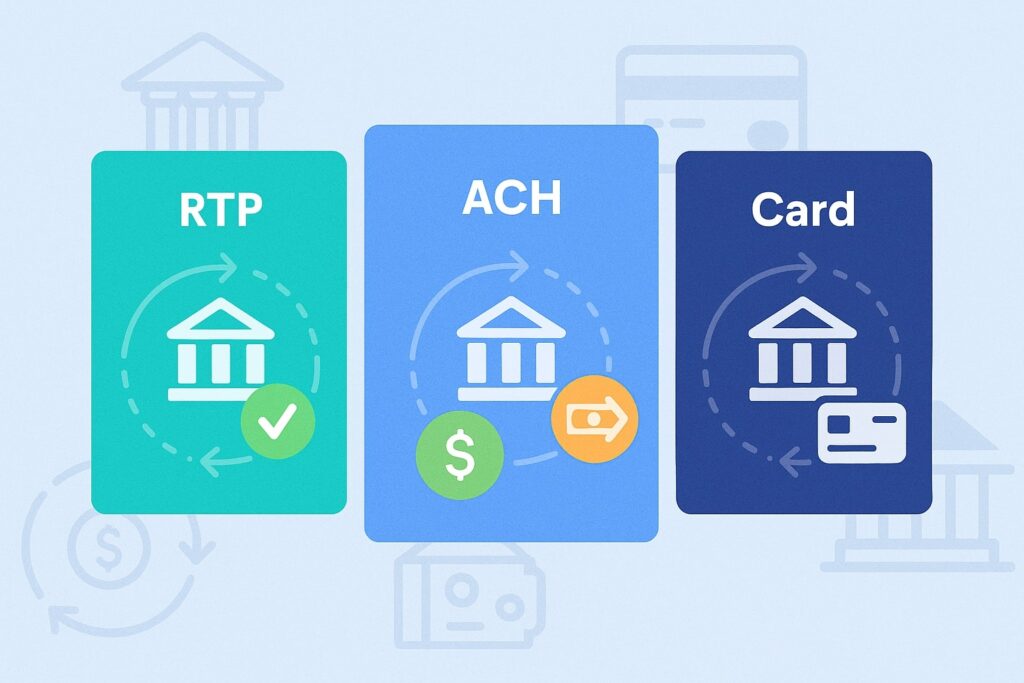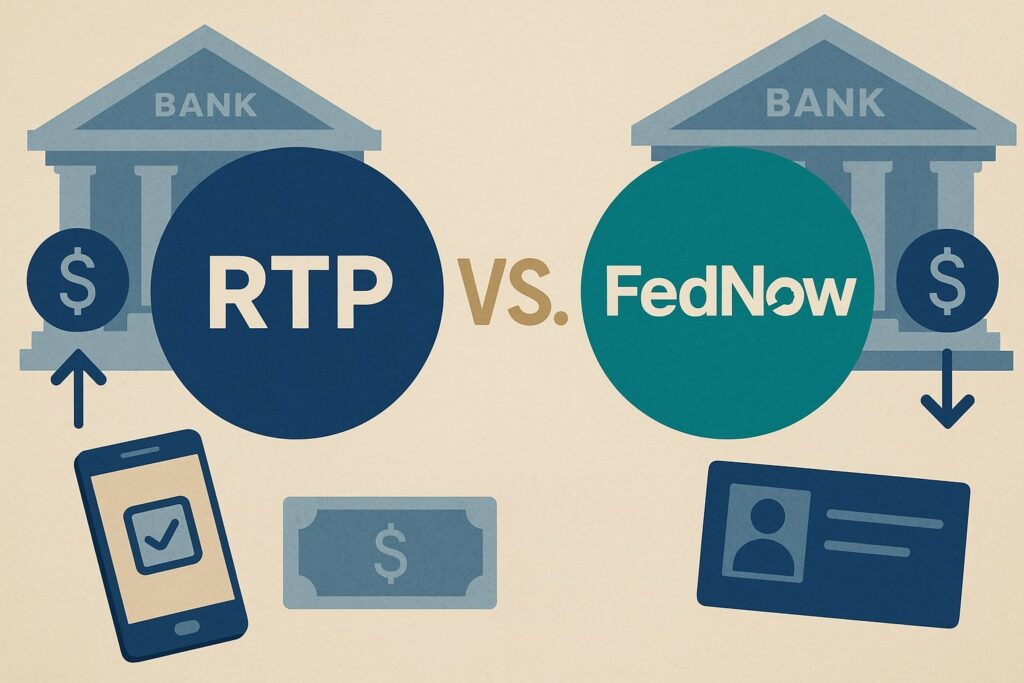
By p2pbusinesspayments October 26, 2025
Real-time payments, often shortened to “RTP” or “instant payments,” move money and the related payment data between U.S. bank accounts in seconds, 24/7/365. Unlike traditional rails that batch and settle later, real-time payments complete clearing, settlement, and funds availability nearly instantly—with finality.
In the U.S., two primary instant rails enable real-time payments: The Clearing House’s RTP® network (launched 2017) and the Federal Reserve’s FedNow® Service (launched 2023). Both rails are credit-push only, operate continuously, and use the ISO 20022 data standard to carry richer remittance information.
For consumers, businesses, and government payers, this means faster cash flow, instant confirmation, and less operational uncertainty compared to ACH, card settlement, or wires in many day-to-day use cases.
Real-Time Payments (RTP) in the U.S.: The Two Rails You Need to Know
The U.S. real-time payments landscape centers on two interoperable-in-practice but separately operated rails:
- The Clearing House RTP® network: RTP is a private-sector rail available to all federally insured depository institutions. It offers instant credit transfers, “Request for Payment” messaging, immediate funds availability, and final and irrevocable settlement for receiving institutions.
In February 2025, RTP raised its per-payment limit from $1 million to $10 million, unlocking larger-value B2B use cases like real estate closings and high-value supplier payments. - The Federal Reserve’s FedNow® Service: FedNow is the Fed’s instant payment infrastructure. It supports customer credit transfers (pacs.008), liquidity management transfers (pacs.009), and Request for Payment (pain.013), with immediate posting and confirmation.
In 2025 the Fed announced the network transaction limit will increase to $10 million effective November 2025 (banks can still set lower internal limits). The default participant limit remains $100,000 unless raised by the bank per risk policies.
Both rails run continuously and deliver immediate posting confirmations to senders and receivers. While ACH has become faster (including same-day settlement windows), it still operates on banking-day schedules rather than true 24/7 finality.
For planning purposes, know that most ACH transactions settle in one business day or less, but they are not instant and not irrevocable in the same way as RTP/FedNow.
How Real-Time Payments Actually Work, Step by Step

Real-time payments compress what used to be a multi-day process into seconds. Here’s what happens behind the scenes on the instant rails:
- Initiation (Credit Push Only): The sender’s institution (or its service provider) authenticates the customer and initiates a credit transfer. RTP and FedNow both disallow debit pulls; instead, they use a Request for Payment (RFP) message to ask a payer to push funds. This structure reduces return risk and supports better control for payers.
- Authorization & Risk Checks: The sending bank runs fraud, sanctions, and limit checks in real time (often including velocity or “account activity threshold” controls). If approved, it forwards the payment message to the network.
- Network Processing: The rail validates the message formatting (ISO 20022), routes to the receiving bank, and orchestrates settlement.
- Settlement & Posting: Settlement is completed immediately on each rail’s underlying mechanism (details below). The receiver’s bank must make funds available immediately after settlement and acknowledge back to the sender that payment is complete.
- Confirmation & Messaging: Both parties receive confirmations. Rich remittance data travels with the payment, enabling automated reconciliation for invoices and payouts.
Because instant payments are designed to be final and irrevocable at the network level (subject to limited error or fraud workflows), operational refunds require a new payment in the opposite direction or a request-for-return process rather than a “chargeback” like cards.
The Settlement Models: Why RTP Feels Different from ACH or Cards

RTP and FedNow both settle in real time, but the mechanics differ:
- RTP’s prefunded joint account at the Federal Reserve: Participating institutions (directly or via funding agents) maintain balances in a joint account at the Federal Reserve Bank of New York.
Each instant payment moves positions within that prefunded pool, which is why settlement is immediate and final—funds are already on deposit. The Federal Reserve’s 2023 order confirms the construct and that interest on the RTP prefunded balance accrues to participating institutions. - FedNow’s central bank settlement: FedNow settles payments in real time on the Federal Reserve’s books and provides liquidity management transfer (LMT) capabilities.
Its fee schedule and message catalog explicitly reference ISO 20022 messages such as pacs.008 (customer credit transfer), pacs.009 (LMT), and pain.013 (RFP), highlighting the standardized data model.
For treasurers, these differences show up in daily cash management. RTP’s prefunding requires forecasting and intraday liquidity planning (or partnering with a funding agent), while FedNow uses central bank settlement and bank-set limits for risk control.
In both cases, receive-only adoption minimizes liquidity impact for smaller institutions ramping into instant payments.
The Message Standard Behind Instant Payments: ISO 20022
A key reason real-time payments support better automation is ISO 20022. Unlike older formats that cram data into abbreviations, ISO 20022 messages have structured fields for remittance, invoice references, tax data, and more.
On FedNow this shows up in pacs.008 and pain.013; RTP uses a parallel set of ISO 20022 messages for credit transfers, RFP, and value-added flows like standalone remittance advice. The result is cleaner straight-through processing (STP), better reconciliation, and less manual posting for accounts receivable and payables teams.
RTP vs. FedNow: Similar Outcomes, Different Governance and Limits

Both rails deliver real-time, irrevocable payments. The practical distinctions that matter to a U.S. business are:
- Operator & governance: RTP is operated by The Clearing House (owned by a consortium of large banks); FedNow is operated by the Federal Reserve Banks. Both are open to all eligible U.S. depository institutions.
- Limits: RTP’s per-payment limit is $10 million (effective Feb. 9, 2025). FedNow announced a network limit increase to $10 million effective November 2025; banks can still set lower internal caps (many keep $100,000 defaults for send to start).
Your bank’s own policy controls the limit you’ll actually see in your online banking or treasury portal. - Settlement model. RTP relies on a prefunded joint account; FedNow uses central bank settlement with LMTs—important for liquidity planning and weekends/holidays.
- Feature set. Both support Request for Payment so a biller or merchant can prompt a payer to approve and send a credit instantly. Both require immediate funds availability and send back confirmations.
- Reach. Participation on both rails continues to expand monthly (thousands of institutions combined), and each rail publishes tooling and stats for adoption.
How Real-Time Payments Compare to ACH, Cards, and Wires
Real-time payments sit between wires (high value, final, but not 24/7 and often expensive) and ACH/cards (ubiquitous but not truly instant). Here’s how RTP/FedNow differ:
- ACH: The ACH network is extraordinarily efficient for payroll and bill pay, and Same Day ACH accelerated availability—but ACH still operates on banking-day windows.
Most ACH settles in one business day or less, not in seconds, and returns/reversals follow established rules. Instant rails remove return risk at the network level by being credit-push and final. - Cards: Card rails authorize in real time, but merchant funding still settles on batch cycles (T+1/T+2) with chargeback rights. For use cases that need cash in seconds (e.g., gig payouts), RTP/FedNow can move funds to a checking account instantly.
- Wires: Fedwire/CHIPS are high-value, irrevocable payments used for large transactions; however, they operate during defined hours and may not be available nights/weekends. Instant rails fill the after-hours gap and, with higher limits, are increasingly viable for many B2B flows.
Key Use Cases for RTP in the U.S. (with Today’s Limits)
As limits and reach grow, instant payments are moving from niche to mainstream. Common, high-ROI use cases include:
- Bill pay with RFP: Billers send an RFP; customers approve and pay instantly, with immediate confirmation and rich data that reconciles automatically. This reduces exceptions, late fees, and call center volume.
- Merchant settlement and marketplace payouts: PSPs/marketplaces fund merchants in seconds—even on weekends—improving seller liquidity and retention.
- Gig worker and earned wage access (EWA): Employers or EWA providers deliver wages on demand; workers see funds immediately and avoid fees tied to slower options.
- Insurance and loan disbursements: Claims and loan proceeds arrive in seconds, improving customer satisfaction and reducing paper checks.
- A2A transfers and wallet cash-outs: Consumers move money between their accounts or off-ramp from wallets to checking instantly.
These use cases are explicitly recognized by industry operators and service providers as top adoption drivers on the RTP rail.
Risk, Compliance, and Fraud Controls for Real-Time Payments
Because real-time payments are final, strong controls must move “left” in the flow:
- Know-Your-Customer (KYC) and onboarding discipline: Since you can’t claw back a payment through a chargeback, vetting and ongoing monitoring are crucial for senders and receivers.
- Transaction limits and velocity controls: Both rails support configurable limits; FedNow also publicized risk-mitigation updates (e.g., account activity thresholds) that institutions can tailor by customer segment.
RTP participants manage risk through funding positions and rules compliance, and both rails expect immediate posting with robust fraud screening. - Request for Return of Funds (RRoF): If a mistake or fraud occurs, participants can initiate an RRoF workflow. This is not a right of reversal; it’s a request that the receiving institution may honor based on rules and evidence.
- Consumer protections: Regulation E may apply to certain unauthorized consumer transactions. Institutions should educate customers on recognizing scams (especially push-payment fraud), enable out-of-band confirmations for high-risk sends, and use machine-learning-based anomaly detection.
- Audit & rules compliance: RTP requires an annual participant self-audit and adherence to operating rules; FedNow participants likewise follow operating procedures and network risk controls.
Implementation Models: How Banks, Fintechs, and Businesses Connect
There are multiple paths to go live with real-time payments:
- Direct participation (banks/credit unions): Connect directly to one or both rails, stand up 24/7 operations, fraud tooling, posting systems, and liquidity processes.
- Use a processor or gateway: Core/processor connections and modern payment gateways offer send, receive, RFP, and reporting APIs that abstract rail differences.
- Leverage a funding agent (RTP): Smaller institutions can rely on funding agents that manage the prefunded joint account obligations and liquidity transfers to smooth adoption.
- Receive-only first: Many institutions start by receiving instant payments (low liquidity impact), then expand to send once fraud and operations mature. Industry guidance recognizes receive-only as a fast path to customer value.
The End-to-End RTP Flow for a Business Payment (Example)
Scenario: A wholesaler pays a supplier $850,000 on Saturday night.
- AP system (or treasury portal) selects RTP based on amount, timing, and supplier preference.
- The bank verifies limits and risk signals, then sends an ISO 20022 message into the RTP rail.
- Settlement occurs against the bank’s prefunded RTP position at the Fed; the supplier’s bank immediately credits the supplier’s account.
- Both parties receive confirmations; the payable closes with full remittance data. No waiting for a banking day, no suspense posting, and no next-day reconciliation.
For a smaller payment where the supplier prefers FedNow, the sequence is similar, but settlement posts on the Federal Reserve’s books with immediate availability and network-level confirmation.
Pricing, Fees, and Operating Windows
- Operating hours. Both RTP and FedNow operate 24/7/365 with immediate posting requirements.
- Fees. FedNow publishes itemized fees (e.g., per-item origination, RFP, and liquidity transfers), with 2025 program notes indicating discounts and “on-us” pricing considerations.
RTP pricing is set by The Clearing House and shared with participants and providers; your actual costs depend on your institution or processor. - Treasury and cash management impact. With continuous settlement, treasurers should revisit intraday liquidity playbooks, weekends/holidays coverage, and exception queues that used to wait until Monday morning.
What Changed in 2025: Higher Limits and Broader Use
Two 2025 milestones materially expanded instant payment utility:
- RTP’s limit increased to $10 million (Feb. 9, 2025). This removed a practical barrier for many B2B transactions and drove a surge in higher-value instant payments. Banks like Bank of America publicized adoption in large corporate use cases right after the change.
- FedNow’s announced jump to a $10 million network limit (effective Nov. 2025). This aligns the rails at a similar ceiling (subject to bank-set limits), widening the aperture for large-ticket instant payments on nights, weekends, and holidays.
RTP for U.S. Businesses: A Practical Adoption Checklist
- Map use cases (bill pay with RFP, payouts, A2A, supplier payments) and quantify ROI against today’s settlement delays and reconciliation costs.
- Confirm counterparties’ readiness on RTP and FedNow; your bank/processor can check routing-number enablement and reach.
- Set risk guardrails (per-customer and per-transaction limits, velocity, high-risk recipient controls) and define weekend escalation paths.
- Enable RFP for invoice presentment and instant receivables matching; tune your ERP posting rules for ISO 20022 fields.
- Plan liquidity (especially for RTP prefunding) or appoint a funding agent; rehearse overnight and holiday scenarios.
- Train AP/AR and support on the finality model, return-of-funds workflows, and customer education to reduce push-payment scams.
Frequently Asked Questions (FAQs)
Q.1: Are real-time payments “irrevocable,” and what happens if I send money to the wrong account?
Answer: Yes—at the network level, real-time payments are final and irrevocable once accepted and settled. If you send funds to the wrong party or fall for a scam, your bank can initiate a Request for Return of Funds (RRoF) to the receiving bank.
Returns are voluntary and governed by network rules; there is no card-style chargeback. This is why pre-send validation, payee verification, and internal approval workflows are essential for higher-value sends.
Q.2: What are the current transaction limits for RTP and FedNow?
Answer: As of October 25, 2025 (U.S. time), RTP supports up to $10 million per payment. FedNow announced an increase of its network limit to $10 million effective November 2025; banks can still set lower participant limits. Always check your bank’s current limits before initiating a high-value instant payment.
Q.3: How do instant payments differ from Same Day ACH?
Answer: Same Day ACH is fast but still runs on banking-day windows with cutoff times. Most ACH settles in one business day or less, but it is not 24/7 and supports returns and reversals under NACHA rules. Real-time payments settle in seconds at any hour, with immediate funds availability and network-level finality.
Q.4: Do RTP and FedNow support invoice data and remittance details?
Answer: Yes. Both rails use ISO 20022 messages, allowing structured remittance fields and invoice references to flow with the payment. This is why AR teams often see fewer exceptions and faster cash applications when customers pay via RFP + instant credit.
Q.5: If I’m a small bank or credit union, can I adopt RTP without managing prefunding myself?
Answer: Yes. Many institutions use funding agents to manage the RTP joint account obligations, smoothing liquidity and operations while they build experience. You can also start receive-only to deliver value with minimal liquidity risk, then add send once controls mature.
Q.6: Are there special compliance requirements for RTP participants?
Answer: RTP participants must follow Operating and Participation Rules, complete an annual self-audit, and adhere to risk and fraud requirements.
FedNow participants comply with its Operating Procedures and associated controls. Your provider and bank partners typically operationalize these frameworks in your connectivity and agreements.
Expert Tips to Maximize Real-Time Payments ROI
- Bundle RFP with your invoices: Drive adoption by embedding a “Pay Now” experience that posts automatically to AR and reduces exception handling.
- Prioritize high-pain use cases first: Weekend merchant settlement, instant payouts, or high-value B2B where emails and wires create delays. The new RTP and FedNow limits broaden these opportunities substantially.
- Tune limits dynamically: Start with conservative per-client limits and adjust based on history and fraud posture. Leverage network and bank-level tools (e.g., account activity thresholds on FedNow).
- Educate players about finality: A simple pre-send confirmation step (“Are you sure?”) plus payee name matching can dramatically reduce misdirected or scam-induced pushes.
- Plan liquidity for nights/weekends: If you’re sending at scale on RTP, align treasury with a funding agent or liquidity playbook to avoid failed sends due to insufficient prefunded balance.
Conclusion
Real-time payments have matured from novelty to necessity. With RTP at $10 million per-payment today and FedNow headed to $10 million in November 2025, the rails now cover everything from gig payouts to large-ticket B2B transactions—any time, any day.
For U.S. businesses, the payoff is better cash flow, fewer exceptions, and happier customers. The tradeoff is a shift in risk posture: controls must act before the money moves because instant payments are final.
If you map your use cases, adopt RFP, set smart limits, and plan liquidity, RTP and FedNow can streamline your financial operations and give your company a competitive edge.